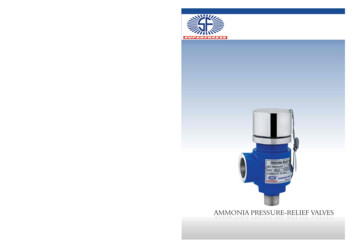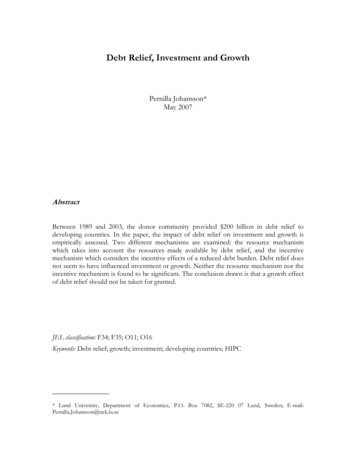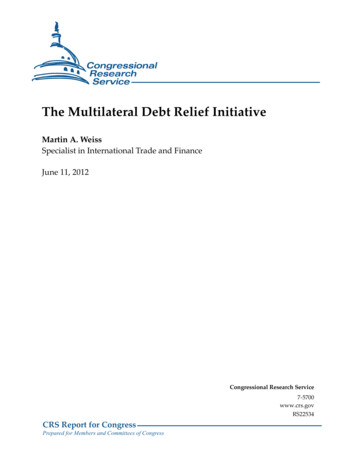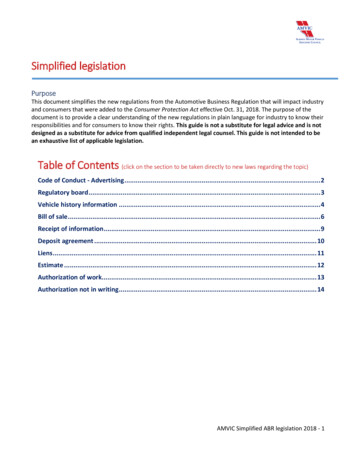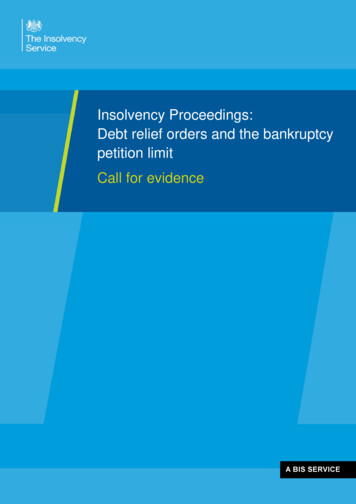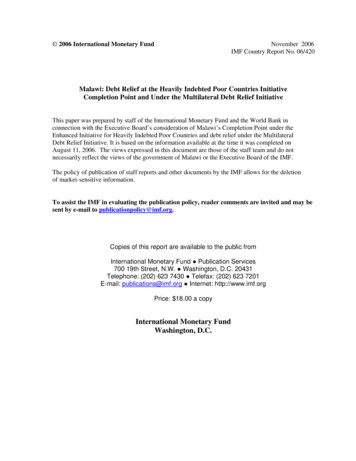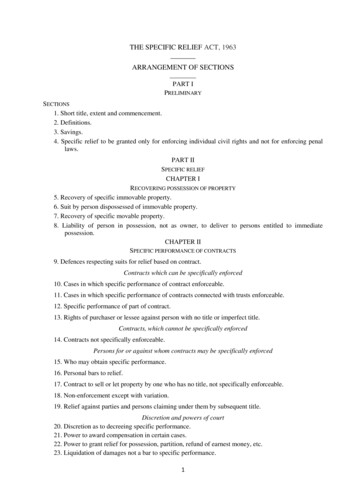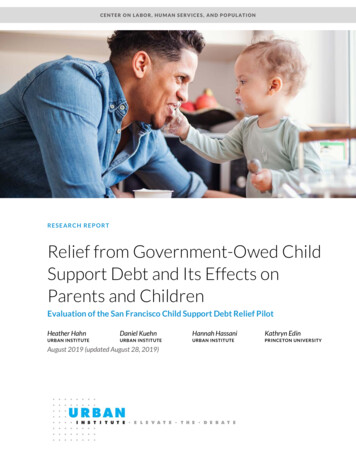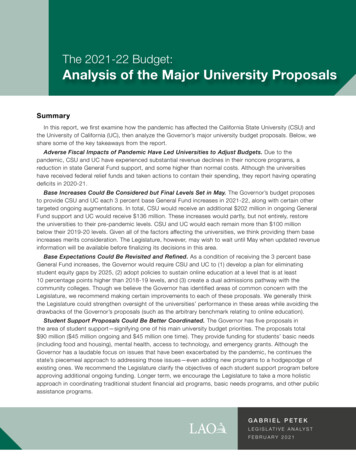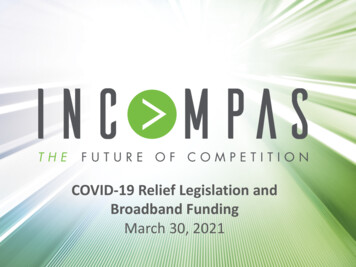
Transcription
COVID-19 Relief Legislation andBroadband FundingMarch 30, 2021
OVERVIEW - COVID LEGISLATION AND BROADBANDFUNDING I. Omnibus or Consolidated Appropriations Act of2021– NTIA Grant Programs– Emergency Broadband Benefit Program (EBB) – FCC II. American Rescue Plan––––Capital Projects Fund – U.S. TreasuryHomeowners Assistance Fund – U.S. TreasuryState and Local Recovery Funds – U.S. TreasuryEmergency Connectivity Fund – FCC III. LIFT America Act - U.S. House Infrastructure Bill– Accessible, Affordable Internet for All Act introduced in House andSenate1
I. OMNIBUS / CONSOLIDATED APPROPRIATIONSACT OF 2021 (PASSED) Passed by Congress in December 2020 ( 900 billion)– Total of 7 billion for broadband funding includes: 1.9 billion for "rip and replace" efforts to remove Huaweiand ZTE equipment from U.S. networks. 250 million for the FCC's COVID-19 Telehealth Program. 65 million to improve broadband mapping at FCC. The National Telecommunications and Information Administration(NTIA) received funding from the Consolidated Appropriations Actof 2021 for broadband deployment grant programs. The statutetasks NTIA with managing three funding initiatives: Tribal Broadband Connectivity Grants ( 1 billion); Broadband Infrastructure Deployment Grants ( 300 million);and The Connecting Minority Communities Pilot Program ( 285million)2
RIP AND REPLACE UPDATE FCC recently adopted a notice of proposed rulemaking (NPRM) in February 2021.The FCC voted to seek comment on rules for the rip-and-replacement program,including:– Raising the cap on eligibility for participation in the program to providers with 10 millionor fewer customers– What constitutes acceptable uses of reimbursement program disbursements– Eligibility of replacement equipment and services– Modifications to the prioritization plans in the event that requests for reimbursementexceed the 1.895 billion appropriation– Modifying the scope of equipment and services eligible for reimbursement to allowrecipients to use reimbursement funding to remove Huawei or ZTE equipment andservices obtained on or before June 30, 2020– The funding does not specify a preference for wireless networks or wired networks.Comments are due by April 12, 2021, and reply comments are due by April 26,2021.In addition, the FCC is seeking comment on a report it has just issued withpreliminary eligible expenses and costs for securing the nation's criticalcommunications network infrastructure.– Comments Due: April 26, 20213
FCC’s COVID-19 Telehealth ProgramUpdate In December 2020, Congress appropriated an additional 249.95 million for asecond round of funding for the program under the Consolidated AppropriationsAct of 2021.After collecting public input on how to improve the program in January 2021,Acting Chairwoman Jessica Rosenworcel recently circulated a Report and Orderthat would, if approved by the Commission, launch the second round of theprogram and do the following: Establish a system for rating applicants, with more attention paid to hardest-hit and lowincome areas as well as projects that failed to gain approval in the first round, those inhealthcare provider shortage areas and Tribal communities.Ensure “equitable nationwide distribution of funding so that each state, territory, andthe District of Columbia will receive funding since the program’s inception.” Last year’sprogram funded projects in 47 states, Washington DC and Guam but sent no money toHawaii, Alaska or Montana.Set a deadline for applications, rather than reviewing programs as they are submitted,so that all projects can be reviewed at the same time.Award funding in two phases, so that approved projects can be funded quickly and therest have an opportunity to provide more information to qualify for the second ram4
NTIA PROGRAMS Broadband Connectivity Grants– The Act directs the Department of Commerce's National Telecommunicationsand Information Administration (NTIA) to manage two new grant programs forbroadband infrastructure construction: Tribal Broadband Connectivity Grants ( 1 billion) Broadband Infrastructure Program Grants for State and LocalGovernment Partnerships ( 300 million) Office of Minority Broadband Initiatives– The Act includes the Connecting Minority Communities Act, establishingwithin NTIA an Office of Minority Broadband Initiatives. Connecting Minority Communities Pilot Program ( 285 million) Office of Internet Connectivity and Growth– Creates a new Office of Internet Connectivity and Growth within NTIA topromote and track broadband growth and federal spending on broadbandinfrastructure projects that use any federal support.5
NTIA’s Broadband Connectivity Grants Tribal Broadband Connectivity Grants ( 1 billion): Grants “To expand access toand adoption of – (A) broadband service on Tribal land; or (B) remote learning,telework, or telehealth resources during the COVID-19 pandemic.”– Who’s Eligible- Tribal governments, Tribal organizations, TCUs, theDepartment of Hawaiian Home Lands on behalf of the Native HawaiianCommunity, and Native Corporations (subgrantees allowed)– What can the grants be used for? Infrastructure (including submarine cablelanding stations), affordability programs, telehealth, distance learning, digitalinclusion efforts, broadband adoption activities Broadband Infrastructure Program Grants ( 300 million): Grants for coveredbroadband projects, defined as competitively and technologically neutral projectsfor the deployment of fixed broadband service in a census block with at least onehousehold or business that does not have access to 25/3 Mbps service.– Who’s Eligible- Partnerships between a state, or one or more politicalsubdivisions of a state, and providers of fixed broadband service. ETCdesignation is not required.– What can the grants be used for? Infrastructure6
NTIA PROGRAMS (CONT.)NTIA’s Office of Minority Broadband Initiatives Connecting Minority Communities Pilot Program ( 285 million): Grants toeligible recipients in anchor communities for the purchase of broadbandinternet access service or any eligible equipment, or to hire and traininformation technology personnel.– Who’s Eligible- Historically Black and Tribal colleges and universities,Minority-serving institutions, and minority business enterprises andnonprofits.– What can the grants be used for? Devices, service, adoption/digitalliteracy, hiring/training technology personnel (not infrastructure)NTIA Application Timelines - NTIA is working on a notice of funding opportunity for eachprogram, which will open up the application window. They are targeting publishing thesein spring of 2021, and then to begin accepting applications in the summer of 2021. Please check NTIA’s website at https://broadbandusa.ntia.doc.gov/ for updates onthe application timeline as they become available.7
EMERGENCY BROADBAND BENEFITEmergency Broadband Benefit Program Establishes a temporary 3.2 billion Emergency BroadbandBenefit (“EBB”) program that will reimburse participatingproviders up to 50 per month ( 75 in tribal areas) for providingdiscounted broadband service to an eligible household. https://www.fcc.gov/broadbandbenefit Managed by the FCC and USAC The Emergency Broadband Benefit (“EBB”) will provide adiscount of up to 50 per month towards broadband service foreligible households and up to 75 per month for households onTribal lands. Eligible households can also receive a one-timediscount of up to 100 to purchase a laptop, desktop computer,or tablet from participating providers if they contribute 10- 50toward the purchase price. The Emergency Broadband Benefit is limited to one monthlyservice discount and one device discount per household.8
Consumers Eligible for the EBB A household is eligible if one member of the household:– Qualifies for the Lifeline program;– Receives benefits under the free and reduced-price school lunchprogram or the school breakfast program, including through theUSDA Community Eligibility Provision, or did so in the 20192020 school year;– Received a Federal Pell Grant during the current award year;– Experienced a substantial loss of income since February 29,2020 and the household had a total income in 2020 below 99,000 for single filers and 198,000 for joint filers; or– Meets the eligibility criteria for a participating providers' existinglow-income or COVID-19 program.9
EBB Providers The program is open to all residential broadbandproviders, not just those currently offeringLifeline services. Providers do not need to be an ETC, but mustobtain FCC approval to participate. Participating providers will receivereimbursement from the program for deliveringqualifying broadband services or devices toeligible households.10
EBB Provider Timeline Non-ETC Provider Application & Alternative EligibilityVerification Process Portal Opens on March 8, 2021 with adeadline of March 22, 2021 (to be filed with WCB) Provider Election Notice Inbox Opens – March 11, 2021 (tobe filed with USAC) Following the close of the priority application window, theBureau and USAC will announce a uniform start date onwhich providers can being to enroll subscribers that willallow for processing of applications and elections.Providers are expected to update their systems andenrollment processes during this time, while USAC willsimultaneously modify existing Lifeline processes toaccommodate the EBB.11
II. AMERICAN RESCUE PLAN (PASSED) American Rescue Plan Act signed into law by PresidentBiden on March 11, 2021 ( 1.9 trillion) Broadband Related Funds– Capital Projects Fund ( 10 billion)* – U.S. Treasury– Homeowners Assistance Fund ( 10 billion) – U.S.Treasury– State and Local Fiscal Recovery Fund ( 350 billion)*– U.S. Treasury– Emergency Connectivity Fund ( 7.17 billion) – FCC*Must Spend Funds by Dec. 31, 202412
Capital Projects Fund ( 10 billion) The U.S. Treasury Department to provide 10 billion for states, territories, and Tribesto cover the costs of capital projects including broadband infrastructure that aredirectly enabling work, education, and health monitoring, including remote options, inresponse to the pandemic.– The Capital Projects Fund takes critical steps to addressing the challenges faced bythe pandemic, especially in rural America and low- and moderate-incomecommunities, helping to ensure that all communities have access to the highquality, modern infrastructure needed to thrive, including internet access.– Payments will be: 100 million to each state, 100 million to Puerto Rico, 100 million to theDistrict of Columbia, 100 million in equal shares to the Virgin Islands, Guam,American Samoa, Northern Mariana Islands, Marshall Islands, FederatedStates of Micronesia, and Republic of Palau, and 100 million to Tribalgovernments and Hawaii (in addition to the previous allocation as a state)with half allocated to each. The remaining amounts will be made by the Secretary of the Treasury to thestates based on population (50%), rural population (25%), and low-incomepopulation (25%).– Awaiting Treasury Guidance to be released within 60 days of Act’s passage.13
Homeowners Assistance Fund ( 10 billion) Includes 9.961 billion for a new Homeowners Assistance Fund at the U.S.Treasury Department. Treasury will make grants to states to administer programs assistinghomeowners with mortgage payments; financial assistance to reinstate amortgage related to a period of forbearance, delinquency, or default;principal reduction; interest rate reductions; utilities and internet service;homeowners insurance, flood insurance, and mortgage insurance; and otherassistance to promote housing stability for homeowners.– As defined, the fund can be used for “internet service, including broadbandinternet access service.” States must use at least 60% of their grants to assist homeowners earning nomore than 100% of the greater of area median income or nationwide medianincome. With the remaining funds, states must prioritize socially oreconomically disadvantaged individuals as defined by the Small Business Act. Funding is available until September 30, 2025.14
State and Local Fiscal Recovery Fund( 350 billion) The new law provides 219.8 billion to states, territories and Tribal entities for fiscalyear 2021 and will remain available until December 31, 2024.Funds can be used for local economic recovery purposes, including assistance tohouseholds, small businesses and nonprofits, assistance to hard-hit industries liketourism, travel, and hospitality, and water, sewer, and broadband infrastructureinvestment. No money is earmarked specifically for broadband.Here's how the funds are to be allocated:– 195.3 billion for payments to the 50 states and the District of Columbia. 25.5billion will be allocated equally among the 50 states and the District of Columbia.– 20 billion toward payments to Tribal governments. 1 billion will be allocatedequally across Tribal governments and 19 billion will be allocated in an amountdetermined by the Secretary of the Treasury.– 4.5 billion for payments to Territories. Half will be dispersed equally and theother half will be allocated as an additional amount in proportion to the relativepopulation a territory covers compared to the overall population of all territories.Similar to the state fund, the new law provides 130.2 billion to localgovernments and counties for fiscal year 2021 and will remain available untilDecember 31, 2024.15
Emergency Connectivity Fund( 7.17 billion) The Emergency Connectivity Fund is managed by the FCC and USAC andprovides reimbursement support for the purchase during the COVID-19emergency of “eligible equipment or advanced telecommunications orinformation services (or both)” to provide:– For E-rate eligible schools, for use by schools, students and staff outsidethe school building; and– For E-rate-eligible libraries, for use by patrons outside the library location.Eligible equipment includes: Wi-Fi hotspots, modems, routers, devicescombining a modem and router, and connected devices. A connected deviceis defined as a “laptop computer, tablet computer or similar end-user devicethat is capable of connecting to advanced telecommunications andinformation services.”The FCC may set an upper limit on the amount of reimbursement forbroadband service and devices, but Congress envisions both being offered tostudents and library patrons at no cost.16
Emergency Connectivity Fund (Cont.) COVID-19 emergency period is defined as beginning onJanuary 27, 2020, and ending on June 30 one year after theSecretary of Health and Human Services determines that apublic health emergency no longer exists. E-rate providers are eligible, and FCC is seeking comment onwhether new competitive bidding should be required. FCC proposes to restrict new network builds. FCC Public Notice comments due April 5, 2021, and FCC willpromulgate rules within 60 days of enactment of theprovision.17
III. LIFT AMERICA ACT - INTERNET FOR ALL(PENDING)As part of the House Democrats Infrastructure Bill, LIFT America Act, House MajorityWhip James Clyburn (D-SC) and Sen. Amy Klobuchar (D-MN) reintroduced on March11, 2021 the Accessible, Affordable Internet for All Act: The legislation authorizes over 94 billion to ensure unserved and underservedcommunities have affordable high-speed internet access. Specifically, the bill calls for:– 80 billion to deploy secure and resilient broadband infrastructure forcommunities nationwide.– 15 billion in grants for the deployment and implementation of NextGeneration 9-1-1 services across the country to protect Americanlives through more accessible, interoperable, effective, and resilient 9-1-1services that allow callers to send text messages, images, or videos to 9-1-1 intimes of emergency.– 5 billion over five years for low-interest financing of broadband deployment.– 6 billion in additional funds for the FCC's Emergency Broadband BenefitProgram.– 1 billion to establish two new grant programs which will help Americans builddigital skills.– 2 billion more for the Emergency Connectivity Fund created by the AmericanRescue Plan.18
Legislative Process LIFT America Act has received a hearing in theHouse. Some Senate Dems have clearly signaledinfrastructure bill must be bipartisan. Biden Administration sending signals that maynot be the case. Expect Spring/Summer push for infrastructurebill. INCOMPAS working with members to obtainadditional funding opportunities and streamlinedprocesses.19
QUESTIONSIf any questions, please contactAndrew Mincheff, Government Relations Directoramincheff@incompas.orgINCOMPASConnect. Learn. Advocate.
homeowners insurance, flood insurance, and mortgage insurance; and other assistance to promote housing stability for homeowners. -As defined, the fund can be used for "internet service, including broadband internet access service." States must use at least 60% of their grants to assist homeowners earning no
